Comprehensive Analysis of Big Data: Technologies and Strategies
VerifiedAdded on 2023/04/19
|7
|2069
|464
Report
AI Summary
This report provides a comprehensive overview of Big Data analysis, exploring its core concepts, technologies, and applications. It begins by defining Big Data and its evolution beyond traditional databases, highlighting technologies such as HDFS, MapReduce, and NoSQL. The report then delves into the challenges associated with Big Data, including data acquisition, processing, and interpretation. It also examines various statistical modeling techniques like association rule learning and classification tree analysis. Furthermore, the report emphasizes the potential of Big Data for small organizations, showcasing how they can leverage analytical tools for market research, process efficiency, and customer behavior analysis. The study concludes by discussing the increasing importance of Big Data analytics and Machine Learning for extracting valuable insights and Key Performance Indicators (KPIs).
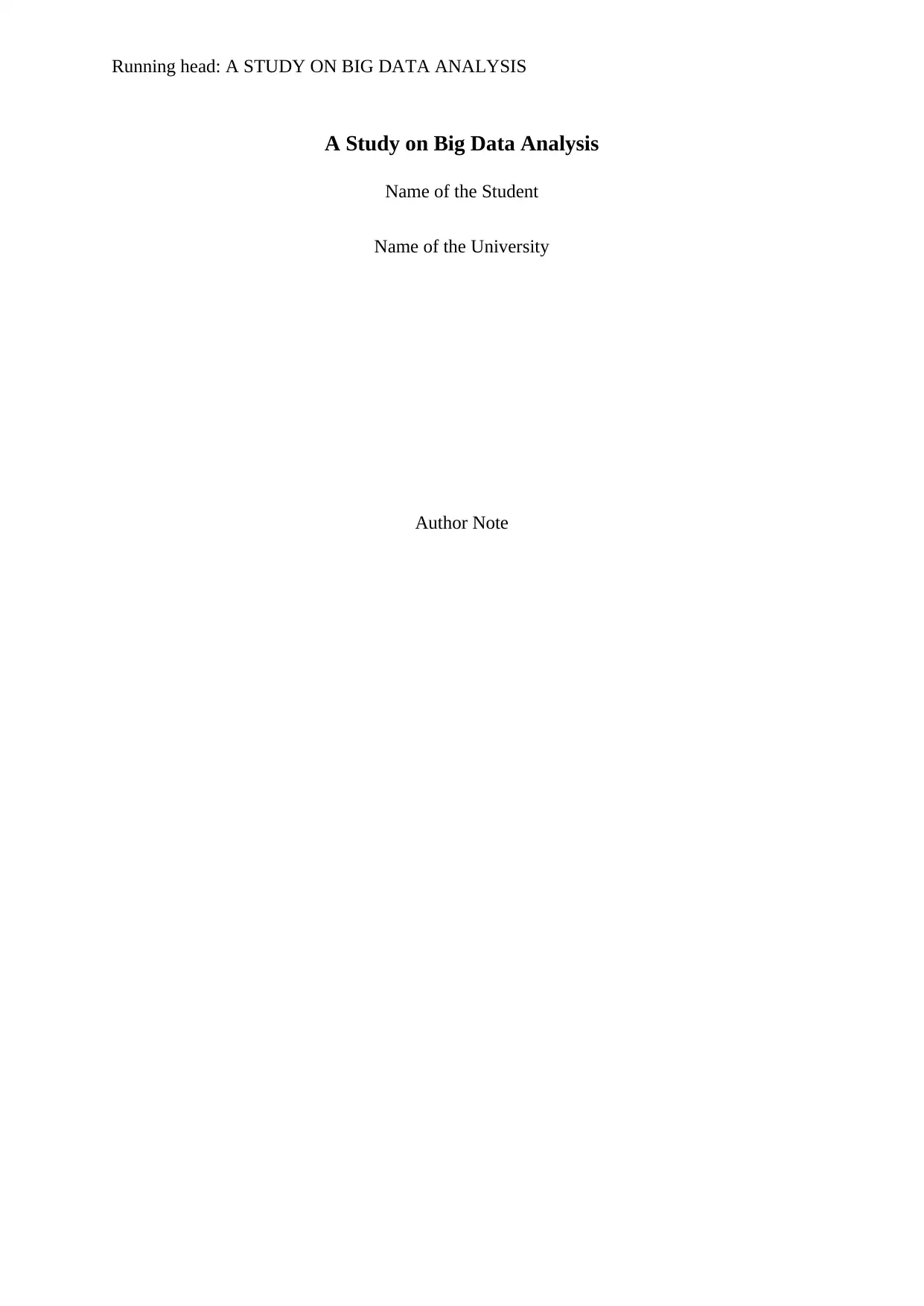
Running head: A STUDY ON BIG DATA ANALYSIS
A Study on Big Data Analysis
Name of the Student
Name of the University
Author Note
A Study on Big Data Analysis
Name of the Student
Name of the University
Author Note
Paraphrase This Document
Need a fresh take? Get an instant paraphrase of this document with our AI Paraphraser
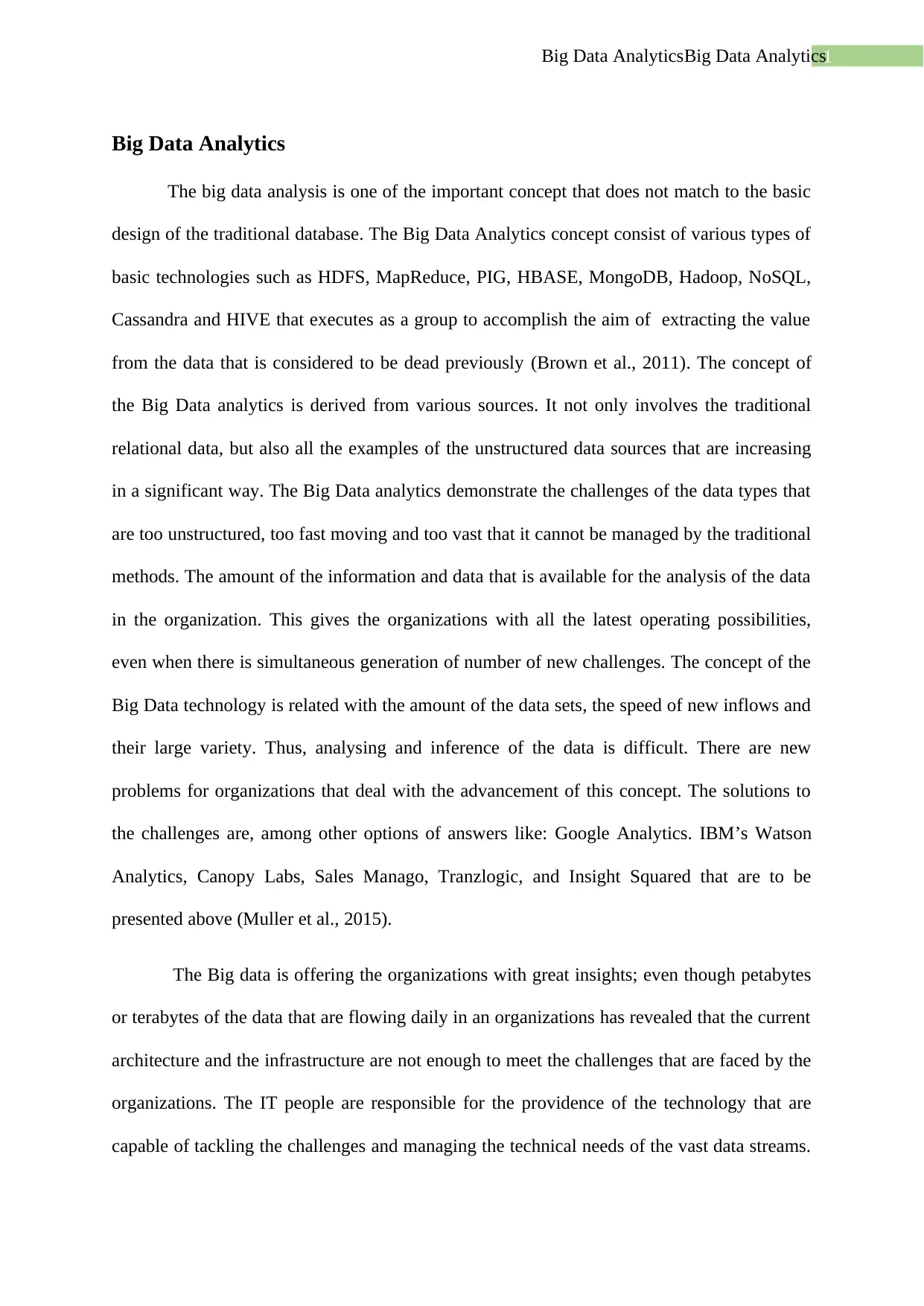
1Big Data AnalyticsBig Data Analytics
Big Data Analytics
The big data analysis is one of the important concept that does not match to the basic
design of the traditional database. The Big Data Analytics concept consist of various types of
basic technologies such as HDFS, MapReduce, PIG, HBASE, MongoDB, Hadoop, NoSQL,
Cassandra and HIVE that executes as a group to accomplish the aim of extracting the value
from the data that is considered to be dead previously (Brown et al., 2011). The concept of
the Big Data analytics is derived from various sources. It not only involves the traditional
relational data, but also all the examples of the unstructured data sources that are increasing
in a significant way. The Big Data analytics demonstrate the challenges of the data types that
are too unstructured, too fast moving and too vast that it cannot be managed by the traditional
methods. The amount of the information and data that is available for the analysis of the data
in the organization. This gives the organizations with all the latest operating possibilities,
even when there is simultaneous generation of number of new challenges. The concept of the
Big Data technology is related with the amount of the data sets, the speed of new inflows and
their large variety. Thus, analysing and inference of the data is difficult. There are new
problems for organizations that deal with the advancement of this concept. The solutions to
the challenges are, among other options of answers like: Google Analytics. IBM’s Watson
Analytics, Canopy Labs, Sales Manago, Tranzlogic, and Insight Squared that are to be
presented above (Muller et al., 2015).
The Big data is offering the organizations with great insights; even though petabytes
or terabytes of the data that are flowing daily in an organizations has revealed that the current
architecture and the infrastructure are not enough to meet the challenges that are faced by the
organizations. The IT people are responsible for the providence of the technology that are
capable of tackling the challenges and managing the technical needs of the vast data streams.
Big Data Analytics
The big data analysis is one of the important concept that does not match to the basic
design of the traditional database. The Big Data Analytics concept consist of various types of
basic technologies such as HDFS, MapReduce, PIG, HBASE, MongoDB, Hadoop, NoSQL,
Cassandra and HIVE that executes as a group to accomplish the aim of extracting the value
from the data that is considered to be dead previously (Brown et al., 2011). The concept of
the Big Data analytics is derived from various sources. It not only involves the traditional
relational data, but also all the examples of the unstructured data sources that are increasing
in a significant way. The Big Data analytics demonstrate the challenges of the data types that
are too unstructured, too fast moving and too vast that it cannot be managed by the traditional
methods. The amount of the information and data that is available for the analysis of the data
in the organization. This gives the organizations with all the latest operating possibilities,
even when there is simultaneous generation of number of new challenges. The concept of the
Big Data technology is related with the amount of the data sets, the speed of new inflows and
their large variety. Thus, analysing and inference of the data is difficult. There are new
problems for organizations that deal with the advancement of this concept. The solutions to
the challenges are, among other options of answers like: Google Analytics. IBM’s Watson
Analytics, Canopy Labs, Sales Manago, Tranzlogic, and Insight Squared that are to be
presented above (Muller et al., 2015).
The Big data is offering the organizations with great insights; even though petabytes
or terabytes of the data that are flowing daily in an organizations has revealed that the current
architecture and the infrastructure are not enough to meet the challenges that are faced by the
organizations. The IT people are responsible for the providence of the technology that are
capable of tackling the challenges and managing the technical needs of the vast data streams.
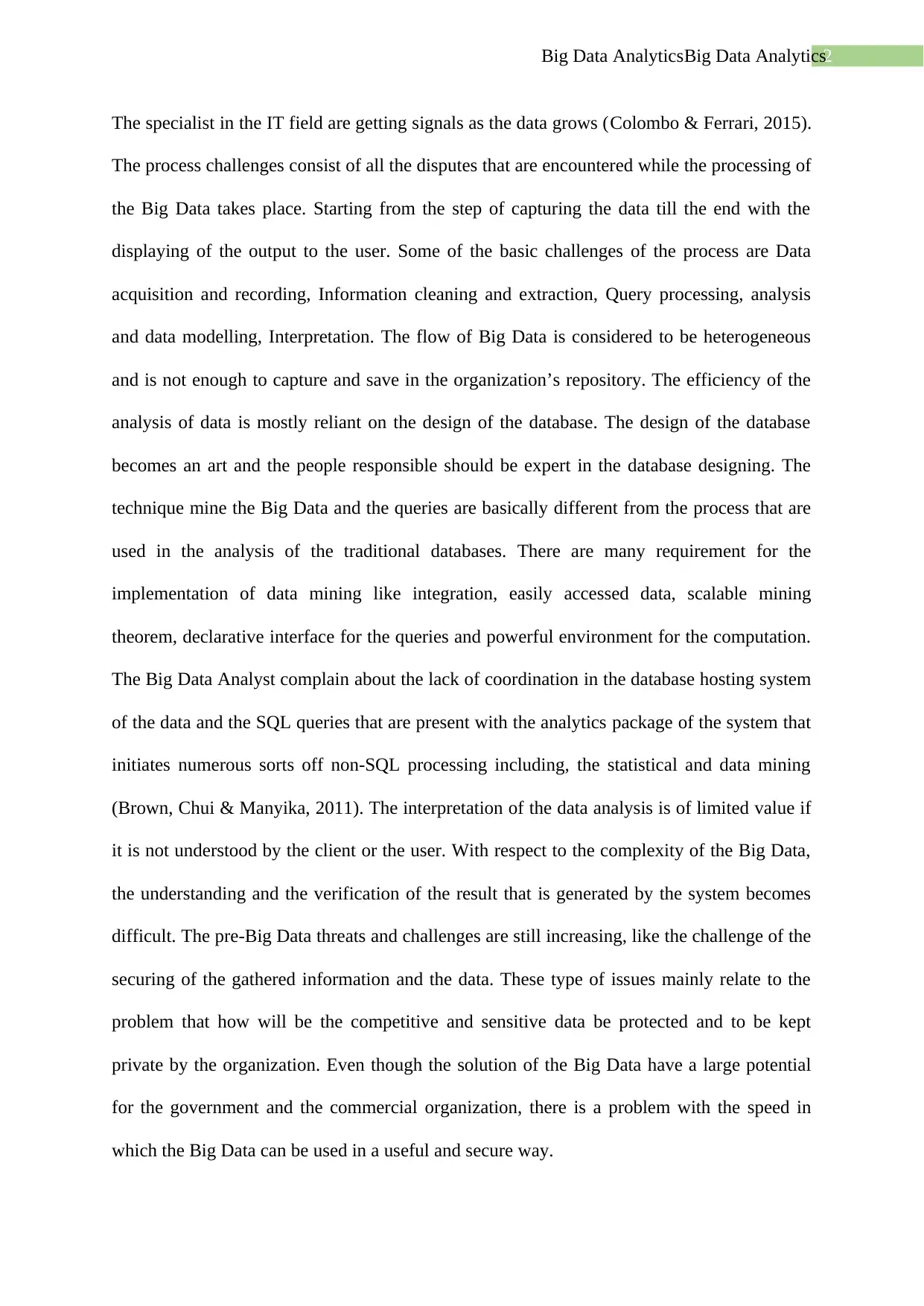
2Big Data AnalyticsBig Data Analytics
The specialist in the IT field are getting signals as the data grows (Colombo & Ferrari, 2015).
The process challenges consist of all the disputes that are encountered while the processing of
the Big Data takes place. Starting from the step of capturing the data till the end with the
displaying of the output to the user. Some of the basic challenges of the process are Data
acquisition and recording, Information cleaning and extraction, Query processing, analysis
and data modelling, Interpretation. The flow of Big Data is considered to be heterogeneous
and is not enough to capture and save in the organization’s repository. The efficiency of the
analysis of data is mostly reliant on the design of the database. The design of the database
becomes an art and the people responsible should be expert in the database designing. The
technique mine the Big Data and the queries are basically different from the process that are
used in the analysis of the traditional databases. There are many requirement for the
implementation of data mining like integration, easily accessed data, scalable mining
theorem, declarative interface for the queries and powerful environment for the computation.
The Big Data Analyst complain about the lack of coordination in the database hosting system
of the data and the SQL queries that are present with the analytics package of the system that
initiates numerous sorts off non-SQL processing including, the statistical and data mining
(Brown, Chui & Manyika, 2011). The interpretation of the data analysis is of limited value if
it is not understood by the client or the user. With respect to the complexity of the Big Data,
the understanding and the verification of the result that is generated by the system becomes
difficult. The pre-Big Data threats and challenges are still increasing, like the challenge of the
securing of the gathered information and the data. These type of issues mainly relate to the
problem that how will be the competitive and sensitive data be protected and to be kept
private by the organization. Even though the solution of the Big Data have a large potential
for the government and the commercial organization, there is a problem with the speed in
which the Big Data can be used in a useful and secure way.
The specialist in the IT field are getting signals as the data grows (Colombo & Ferrari, 2015).
The process challenges consist of all the disputes that are encountered while the processing of
the Big Data takes place. Starting from the step of capturing the data till the end with the
displaying of the output to the user. Some of the basic challenges of the process are Data
acquisition and recording, Information cleaning and extraction, Query processing, analysis
and data modelling, Interpretation. The flow of Big Data is considered to be heterogeneous
and is not enough to capture and save in the organization’s repository. The efficiency of the
analysis of data is mostly reliant on the design of the database. The design of the database
becomes an art and the people responsible should be expert in the database designing. The
technique mine the Big Data and the queries are basically different from the process that are
used in the analysis of the traditional databases. There are many requirement for the
implementation of data mining like integration, easily accessed data, scalable mining
theorem, declarative interface for the queries and powerful environment for the computation.
The Big Data Analyst complain about the lack of coordination in the database hosting system
of the data and the SQL queries that are present with the analytics package of the system that
initiates numerous sorts off non-SQL processing including, the statistical and data mining
(Brown, Chui & Manyika, 2011). The interpretation of the data analysis is of limited value if
it is not understood by the client or the user. With respect to the complexity of the Big Data,
the understanding and the verification of the result that is generated by the system becomes
difficult. The pre-Big Data threats and challenges are still increasing, like the challenge of the
securing of the gathered information and the data. These type of issues mainly relate to the
problem that how will be the competitive and sensitive data be protected and to be kept
private by the organization. Even though the solution of the Big Data have a large potential
for the government and the commercial organization, there is a problem with the speed in
which the Big Data can be used in a useful and secure way.
⊘ This is a preview!⊘
Do you want full access?
Subscribe today to unlock all pages.

Trusted by 1+ million students worldwide
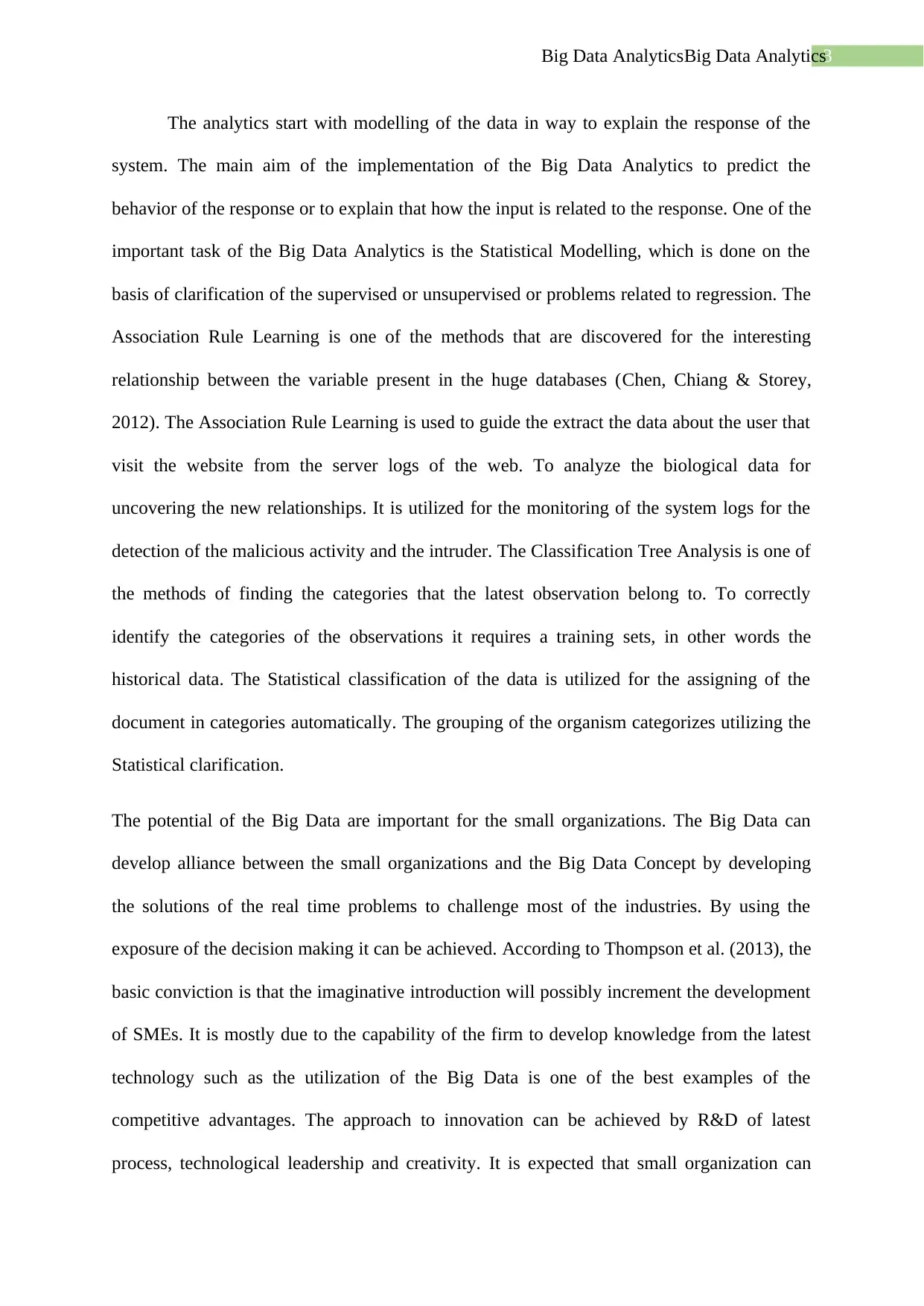
3Big Data AnalyticsBig Data Analytics
The analytics start with modelling of the data in way to explain the response of the
system. The main aim of the implementation of the Big Data Analytics to predict the
behavior of the response or to explain that how the input is related to the response. One of the
important task of the Big Data Analytics is the Statistical Modelling, which is done on the
basis of clarification of the supervised or unsupervised or problems related to regression. The
Association Rule Learning is one of the methods that are discovered for the interesting
relationship between the variable present in the huge databases (Chen, Chiang & Storey,
2012). The Association Rule Learning is used to guide the extract the data about the user that
visit the website from the server logs of the web. To analyze the biological data for
uncovering the new relationships. It is utilized for the monitoring of the system logs for the
detection of the malicious activity and the intruder. The Classification Tree Analysis is one of
the methods of finding the categories that the latest observation belong to. To correctly
identify the categories of the observations it requires a training sets, in other words the
historical data. The Statistical classification of the data is utilized for the assigning of the
document in categories automatically. The grouping of the organism categorizes utilizing the
Statistical clarification.
The potential of the Big Data are important for the small organizations. The Big Data can
develop alliance between the small organizations and the Big Data Concept by developing
the solutions of the real time problems to challenge most of the industries. By using the
exposure of the decision making it can be achieved. According to Thompson et al. (2013), the
basic conviction is that the imaginative introduction will possibly increment the development
of SMEs. It is mostly due to the capability of the firm to develop knowledge from the latest
technology such as the utilization of the Big Data is one of the best examples of the
competitive advantages. The approach to innovation can be achieved by R&D of latest
process, technological leadership and creativity. It is expected that small organization can
The analytics start with modelling of the data in way to explain the response of the
system. The main aim of the implementation of the Big Data Analytics to predict the
behavior of the response or to explain that how the input is related to the response. One of the
important task of the Big Data Analytics is the Statistical Modelling, which is done on the
basis of clarification of the supervised or unsupervised or problems related to regression. The
Association Rule Learning is one of the methods that are discovered for the interesting
relationship between the variable present in the huge databases (Chen, Chiang & Storey,
2012). The Association Rule Learning is used to guide the extract the data about the user that
visit the website from the server logs of the web. To analyze the biological data for
uncovering the new relationships. It is utilized for the monitoring of the system logs for the
detection of the malicious activity and the intruder. The Classification Tree Analysis is one of
the methods of finding the categories that the latest observation belong to. To correctly
identify the categories of the observations it requires a training sets, in other words the
historical data. The Statistical classification of the data is utilized for the assigning of the
document in categories automatically. The grouping of the organism categorizes utilizing the
Statistical clarification.
The potential of the Big Data are important for the small organizations. The Big Data can
develop alliance between the small organizations and the Big Data Concept by developing
the solutions of the real time problems to challenge most of the industries. By using the
exposure of the decision making it can be achieved. According to Thompson et al. (2013), the
basic conviction is that the imaginative introduction will possibly increment the development
of SMEs. It is mostly due to the capability of the firm to develop knowledge from the latest
technology such as the utilization of the Big Data is one of the best examples of the
competitive advantages. The approach to innovation can be achieved by R&D of latest
process, technological leadership and creativity. It is expected that small organization can
Paraphrase This Document
Need a fresh take? Get an instant paraphrase of this document with our AI Paraphraser
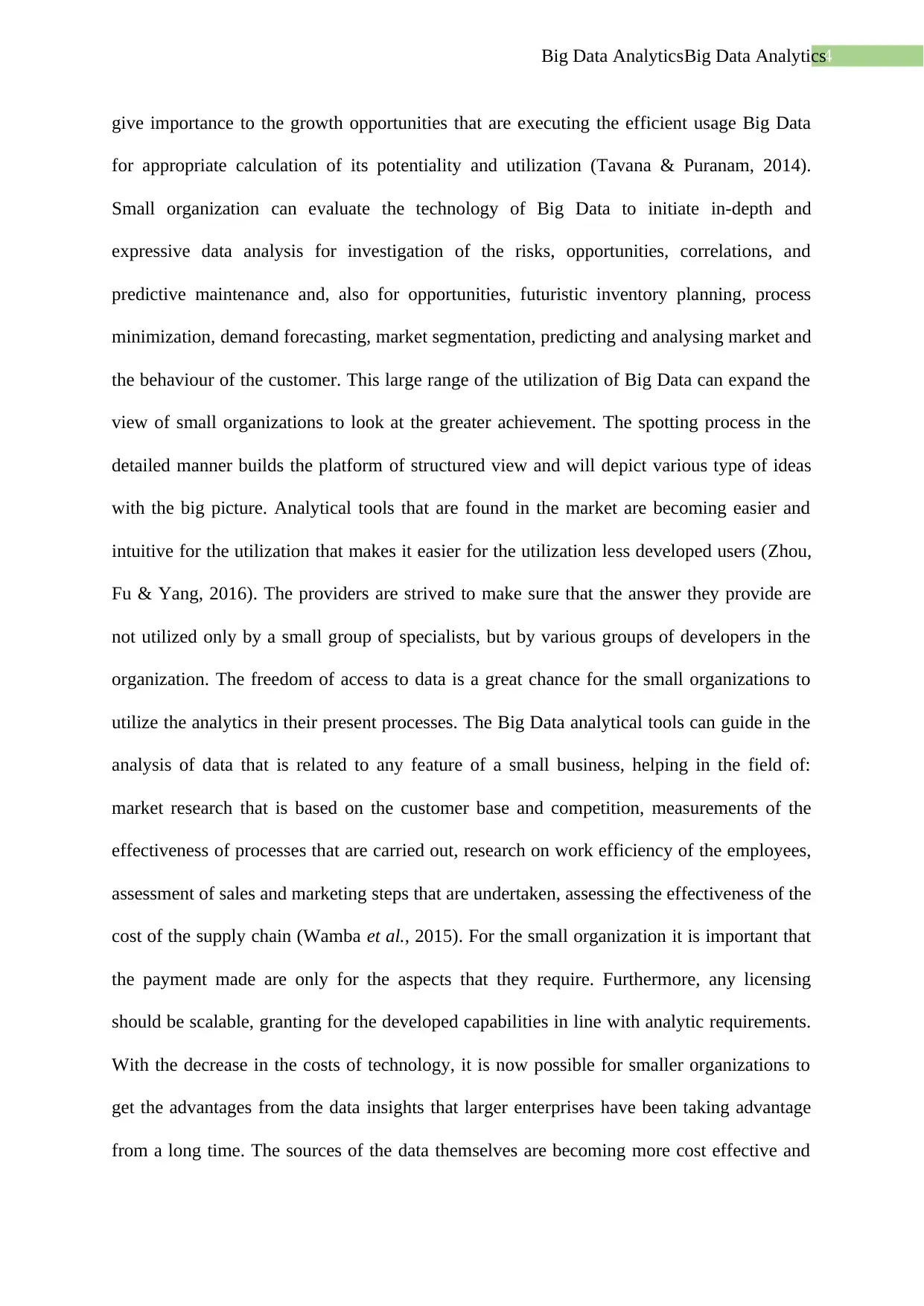
4Big Data AnalyticsBig Data Analytics
give importance to the growth opportunities that are executing the efficient usage Big Data
for appropriate calculation of its potentiality and utilization (Tavana & Puranam, 2014).
Small organization can evaluate the technology of Big Data to initiate in-depth and
expressive data analysis for investigation of the risks, opportunities, correlations, and
predictive maintenance and, also for opportunities, futuristic inventory planning, process
minimization, demand forecasting, market segmentation, predicting and analysing market and
the behaviour of the customer. This large range of the utilization of Big Data can expand the
view of small organizations to look at the greater achievement. The spotting process in the
detailed manner builds the platform of structured view and will depict various type of ideas
with the big picture. Analytical tools that are found in the market are becoming easier and
intuitive for the utilization that makes it easier for the utilization less developed users (Zhou,
Fu & Yang, 2016). The providers are strived to make sure that the answer they provide are
not utilized only by a small group of specialists, but by various groups of developers in the
organization. The freedom of access to data is a great chance for the small organizations to
utilize the analytics in their present processes. The Big Data analytical tools can guide in the
analysis of data that is related to any feature of a small business, helping in the field of:
market research that is based on the customer base and competition, measurements of the
effectiveness of processes that are carried out, research on work efficiency of the employees,
assessment of sales and marketing steps that are undertaken, assessing the effectiveness of the
cost of the supply chain (Wamba et al., 2015). For the small organization it is important that
the payment made are only for the aspects that they require. Furthermore, any licensing
should be scalable, granting for the developed capabilities in line with analytic requirements.
With the decrease in the costs of technology, it is now possible for smaller organizations to
get the advantages from the data insights that larger enterprises have been taking advantage
from a long time. The sources of the data themselves are becoming more cost effective and
give importance to the growth opportunities that are executing the efficient usage Big Data
for appropriate calculation of its potentiality and utilization (Tavana & Puranam, 2014).
Small organization can evaluate the technology of Big Data to initiate in-depth and
expressive data analysis for investigation of the risks, opportunities, correlations, and
predictive maintenance and, also for opportunities, futuristic inventory planning, process
minimization, demand forecasting, market segmentation, predicting and analysing market and
the behaviour of the customer. This large range of the utilization of Big Data can expand the
view of small organizations to look at the greater achievement. The spotting process in the
detailed manner builds the platform of structured view and will depict various type of ideas
with the big picture. Analytical tools that are found in the market are becoming easier and
intuitive for the utilization that makes it easier for the utilization less developed users (Zhou,
Fu & Yang, 2016). The providers are strived to make sure that the answer they provide are
not utilized only by a small group of specialists, but by various groups of developers in the
organization. The freedom of access to data is a great chance for the small organizations to
utilize the analytics in their present processes. The Big Data analytical tools can guide in the
analysis of data that is related to any feature of a small business, helping in the field of:
market research that is based on the customer base and competition, measurements of the
effectiveness of processes that are carried out, research on work efficiency of the employees,
assessment of sales and marketing steps that are undertaken, assessing the effectiveness of the
cost of the supply chain (Wamba et al., 2015). For the small organization it is important that
the payment made are only for the aspects that they require. Furthermore, any licensing
should be scalable, granting for the developed capabilities in line with analytic requirements.
With the decrease in the costs of technology, it is now possible for smaller organizations to
get the advantages from the data insights that larger enterprises have been taking advantage
from a long time. The sources of the data themselves are becoming more cost effective and
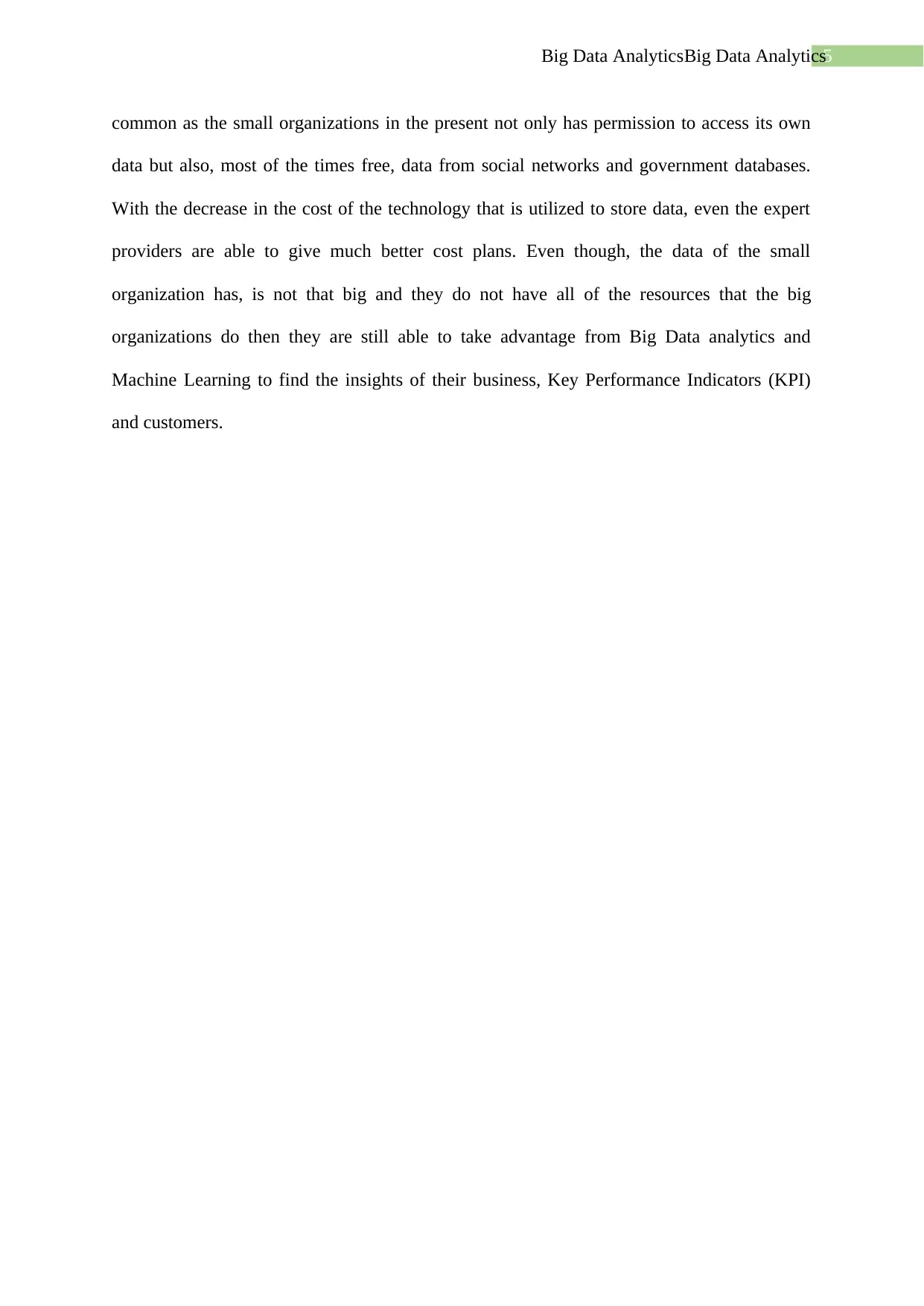
5Big Data AnalyticsBig Data Analytics
common as the small organizations in the present not only has permission to access its own
data but also, most of the times free, data from social networks and government databases.
With the decrease in the cost of the technology that is utilized to store data, even the expert
providers are able to give much better cost plans. Even though, the data of the small
organization has, is not that big and they do not have all of the resources that the big
organizations do then they are still able to take advantage from Big Data analytics and
Machine Learning to find the insights of their business, Key Performance Indicators (KPI)
and customers.
common as the small organizations in the present not only has permission to access its own
data but also, most of the times free, data from social networks and government databases.
With the decrease in the cost of the technology that is utilized to store data, even the expert
providers are able to give much better cost plans. Even though, the data of the small
organization has, is not that big and they do not have all of the resources that the big
organizations do then they are still able to take advantage from Big Data analytics and
Machine Learning to find the insights of their business, Key Performance Indicators (KPI)
and customers.
⊘ This is a preview!⊘
Do you want full access?
Subscribe today to unlock all pages.

Trusted by 1+ million students worldwide
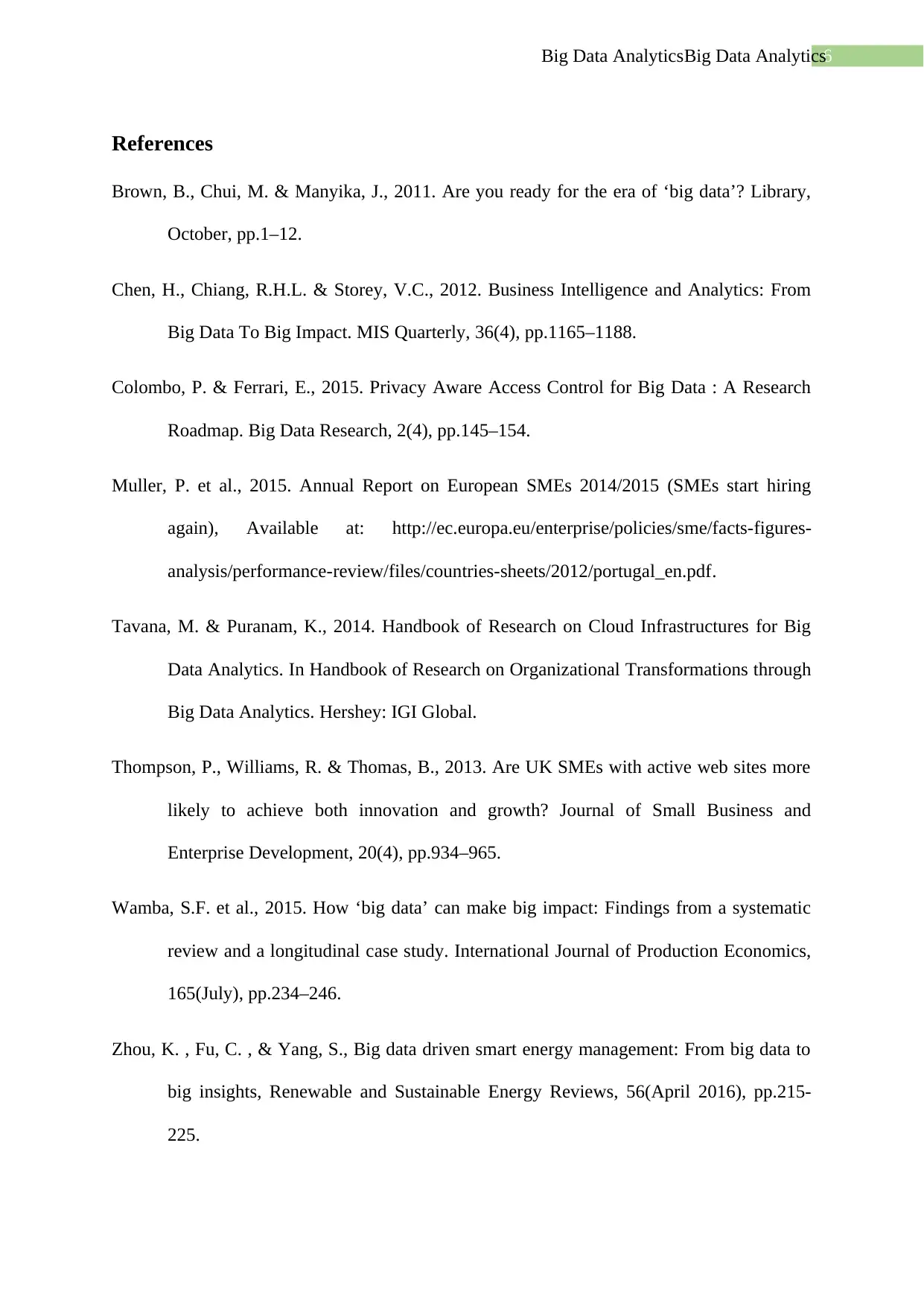
6Big Data AnalyticsBig Data Analytics
References
Brown, B., Chui, M. & Manyika, J., 2011. Are you ready for the era of ‘big data’? Library,
October, pp.1–12.
Chen, H., Chiang, R.H.L. & Storey, V.C., 2012. Business Intelligence and Analytics: From
Big Data To Big Impact. MIS Quarterly, 36(4), pp.1165–1188.
Colombo, P. & Ferrari, E., 2015. Privacy Aware Access Control for Big Data : A Research
Roadmap. Big Data Research, 2(4), pp.145–154.
Muller, P. et al., 2015. Annual Report on European SMEs 2014/2015 (SMEs start hiring
again), Available at: http://ec.europa.eu/enterprise/policies/sme/facts-figures-
analysis/performance-review/files/countries-sheets/2012/portugal_en.pdf.
Tavana, M. & Puranam, K., 2014. Handbook of Research on Cloud Infrastructures for Big
Data Analytics. In Handbook of Research on Organizational Transformations through
Big Data Analytics. Hershey: IGI Global.
Thompson, P., Williams, R. & Thomas, B., 2013. Are UK SMEs with active web sites more
likely to achieve both innovation and growth? Journal of Small Business and
Enterprise Development, 20(4), pp.934–965.
Wamba, S.F. et al., 2015. How ‘big data’ can make big impact: Findings from a systematic
review and a longitudinal case study. International Journal of Production Economics,
165(July), pp.234–246.
Zhou, K. , Fu, C. , & Yang, S., Big data driven smart energy management: From big data to
big insights, Renewable and Sustainable Energy Reviews, 56(April 2016), pp.215-
225.
References
Brown, B., Chui, M. & Manyika, J., 2011. Are you ready for the era of ‘big data’? Library,
October, pp.1–12.
Chen, H., Chiang, R.H.L. & Storey, V.C., 2012. Business Intelligence and Analytics: From
Big Data To Big Impact. MIS Quarterly, 36(4), pp.1165–1188.
Colombo, P. & Ferrari, E., 2015. Privacy Aware Access Control for Big Data : A Research
Roadmap. Big Data Research, 2(4), pp.145–154.
Muller, P. et al., 2015. Annual Report on European SMEs 2014/2015 (SMEs start hiring
again), Available at: http://ec.europa.eu/enterprise/policies/sme/facts-figures-
analysis/performance-review/files/countries-sheets/2012/portugal_en.pdf.
Tavana, M. & Puranam, K., 2014. Handbook of Research on Cloud Infrastructures for Big
Data Analytics. In Handbook of Research on Organizational Transformations through
Big Data Analytics. Hershey: IGI Global.
Thompson, P., Williams, R. & Thomas, B., 2013. Are UK SMEs with active web sites more
likely to achieve both innovation and growth? Journal of Small Business and
Enterprise Development, 20(4), pp.934–965.
Wamba, S.F. et al., 2015. How ‘big data’ can make big impact: Findings from a systematic
review and a longitudinal case study. International Journal of Production Economics,
165(July), pp.234–246.
Zhou, K. , Fu, C. , & Yang, S., Big data driven smart energy management: From big data to
big insights, Renewable and Sustainable Energy Reviews, 56(April 2016), pp.215-
225.
1 out of 7
Related Documents
Your All-in-One AI-Powered Toolkit for Academic Success.
+13062052269
info@desklib.com
Available 24*7 on WhatsApp / Email
![[object Object]](/_next/static/media/star-bottom.7253800d.svg)
Unlock your academic potential
Copyright © 2020–2025 A2Z Services. All Rights Reserved. Developed and managed by ZUCOL.

